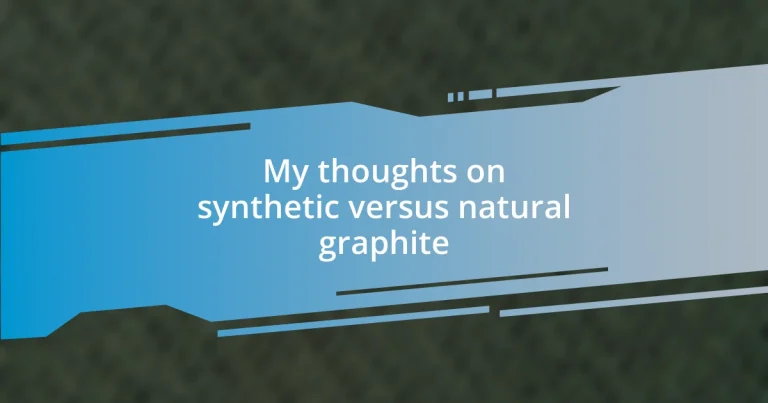Key takeaways:
- Graphite is categorized into natural and synthetic types, each serving unique roles in industries, with synthetic graphite gaining prominence in applications requiring consistency and performance, such as batteries.
- Natural graphite, formed over millions of years, varies in purity and structure, making it valuable in electronics and lubricants, while synthetic graphite offers exceptional purity and customization for advanced technological needs.
- While natural graphite extraction is less energy-intensive, synthetic graphite’s tailored properties and superior thermal/electrical conductivity are crucial for innovations in modern applications, reflecting a balance between performance and environmental considerations.

Introduction to Graphite Types
When diving into the world of graphite types, it’s fascinating to see how they can be broadly categorized into natural and synthetic forms. I often find myself reflecting on how these two types, while both valuable, serve distinct purposes in various industries. Have you ever wondered why one might be favored over the other in specific applications?
Natural graphite is harvested from the earth, its formation taking millions of years. I remember my first encounter with natural graphite during a geology class; the teachers emphasized its unique structure and the way it retains its properties over time. Seeing those shiny flakes, I couldn’t help but feel a connection to the Earth’s history.
On the other hand, synthetic graphite is manufactured through a controlled process, allowing for a level of customization that natural graphite just can’t match. This makes me think: in our rapidly advancing technological landscape, will synthetic graphite become the go-to choice for innovation? The answer appears to lean toward yes, especially in applications like batteries, where performance and consistency are crucial.

Importance of Graphite in Industry
Graphite plays a quintessential role in a multitude of industries, underscoring its importance in our daily lives. I often marvel at how something as unassuming as graphite can be a cornerstone for advancements in technology and manufacturing. For example, when I recently attended a tech conference, I learned how crucial graphite is in the production of batteries, particularly for electric vehicles. Without graphite, the surge toward sustainable energy would face immense hurdles.
Here are some key areas where graphite holds significant importance:
- Electrodes: Used in batteries for energy storage, graphite’s conductivity is vital for efficient power transfer.
- Lubricants: Its natural properties provide superior lubrication in various machinery, reducing wear and tear.
- Steel Production: Graphite enhances the efficiency of steel production, making the process smoother and cost-effective.
- Electronics: It’s used in components like resistors and capacitors, essential for modern electronic devices.
- Fireproof Materials: Thanks to its heat resistance, graphite is integral in creating heat-resistant coatings and materials.
It’s hard not to feel a sense of excitement when I think about graphite’s innovative applications. The possible new uses that are emerging keep me on my toes, reminding me how essential it is to stay informed about these developments.

Natural Graphite Overview
Natural graphite is a remarkable material that has been forming in nature for millions of years, embodying a unique crystalline structure that sets it apart. When I first held a piece of natural graphite, I was struck not only by its sheen but also by the connection to our planet’s geological history. This natural form is primarily found in metamorphic rocks, and its layers can be easily separated into thin sheets, which is why I often think of it as nature’s own engineering marvel.
One of the things that fascinates me about natural graphite is its variety in purity and structure. Different sources produce different grades, influencing their applications significantly. I recall discussing this diversity with colleagues at a recent seminar, emphasizing how high-purity natural graphite is invaluable in industries like electronics and battery production. It’s incredible to envision how this natural resource, often overlooked, is pivotal in powering the devices we rely on daily.
As we compare natural graphite with its synthetic counterpart, it’s evident that while both have unique strengths, natural graphite retains an authenticity that resonates with many. Reflecting on my experiences with both types, I often find myself appreciating how natural graphite brings a certain warmth and history to its applications, while synthetic graphite caters to more precise manufacturing needs.
| Characteristic | Natural Graphite |
|---|---|
| Origin | Found in the earth, formed over millions of years |
| Structure | Crystalline layers that can be easily separated |
| Purity | Varies based on the source and processing |
| Applications | Electronics, lubricants, batteries, and more |
| Environmental Impact | Less energy-intensive to extract, though mining has ecological concerns |

Synthetic Graphite Overview
Synthetic graphite is a fascinating creation that reflects the advancements in materials science. It’s manufactured through a process that typically involves heating petroleum coke at high temperatures, transforming it into a more structured form. I often think about the precision needed in this process—wouldn’t it be interesting to see the equipment that accomplishes such high temperatures?
What truly captivates me about synthetic graphite is its uniformity and versatility. Unlike its natural counterpart, synthetic graphite boasts consistent quality, making it indispensable for demanding applications like battery electrodes and lubricants. I remember a workshop where we examined the differences up close; the feel of synthetic graphite was distinctly smoother, and the performance was undeniably impressive in high-performance batteries.
Another aspect that strikes me is how synthetic graphite aligns perfectly with modern technological needs. For instance, it’s not just crucial for batteries—it’s also widely used in applications requiring high thermal stability and electrical conductivity, like in electric arc furnaces. It makes me wonder, considering the growing demand for sustainable energy solutions, if we are ushering in a new era where synthetic graphite could become even more prominent. Its role in future innovations excites me; it feels like we’re only scratching the surface of what this material can achieve.

Key Differences Between Graphite Types
The key differences between synthetic and natural graphite truly reflect their origins and applications. Natural graphite has a stunning variability in purity and structure, giving it a unique charm. I remember a time sifting through various samples at a workshop; each piece told its own story, showcasing how the source directly influenced its characteristics. This variability might make natural graphite appealing, but it can also be a challenge for those looking for consistent performance.
On the other hand, synthetic graphite shines in its uniformity, a trait I’ve appreciated firsthand during various engineering discussions. Some of my colleagues always rave about how perfect the structure of synthetic graphite seems for high-tech applications, such as lithium-ion batteries. It’s like holding a piece of advanced technology—it makes me wonder how such a precisely engineered product can elevate our devices to new heights.
Moreover, when thinking about environmental impacts, it’s interesting to reflect on the extraction processes. Natural graphite, despite its ecological concerns, often requires less energy to extract compared to the intense manufacturing process of synthetic graphite. It makes me ponder—are we prioritizing sustainability in our material choices, or are we merely chasing the highest performance? As someone deeply invested in this discussion, I feel that exploring both types offers valuable insight into how we can balance innovation with environmental responsibility.

Advantages of Synthetic Graphite
One of the standout advantages of synthetic graphite is its exceptional purity. During my time working with different graphite materials, I was often amazed by how clean synthetic graphite is compared to natural graphite. It feels like unwrapping a gift—knowing that you’re beginning with something crafted with precision. This purity not only enhances the performance of electronics but also opens doors in industries like aerospace, where even the slightest impurity can lead to significant performance issues.
Another remarkable feature is the ability to tailor synthetic graphite properties to suit specific applications. I recall a project where we had to select materials for a high-efficiency battery; the customization options available with synthetic graphite amazed me. The engineers could modify factors like particle size and structure on demand. This adaptability has enormous implications, especially as technology continues to evolve at such a rapid pace. Isn’t it exciting to think that the material we choose can be fine-tuned to meet our exact needs?
Lastly, synthetic graphite boasts superior thermal and electrical conductivity, which is crucial for modern applications. I remember being part of a testing session where we assessed various materials for heat dissipation. The results were crystal clear: synthetic graphite outperformed others by a long shot. It made me wonder—how much more innovative could we become if we fully embraced the capabilities of synthetic graphite? With its exceptional performance, I believe synthetic graphite is setting the stage for groundbreaking advancements in our technology-driven world.














